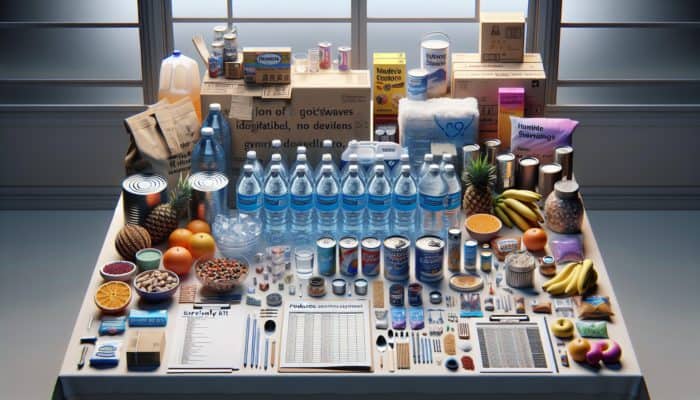Essential Strategies for Preparing for Extreme Heat Events
Gather Your Life-Saving Supply Kit for Heatwaves

Surviving a heatwave requires careful and strategic preparation to ensure that you are well-equipped to handle the extreme conditions. The most important element on your list should be water; strive to have at least one gallon per person for each day of the heatwave. Don’t forget to include extra supplies for pets and for cooking. It’s equally important to stock up on non-perishable food items like canned goods, dried fruits, and nuts, which provide essential nutrition without the need for cooking, helping to maintain lower indoor temperatures. Additionally, consider acquiring <a href="https://survivalbite.com/emergency-hydration-essential-tips-for-survival/">hydration salts</a> and electrolyte solutions that replenish essential minerals lost during extreme heat conditions. These items are easy to find in local pharmacies or health stores, allowing you to prepare effectively for an incoming heatwave.
When it comes to essential medications, ensure that you have sufficient supplies of both prescription and over-the-counter medications, particularly those that address heat-related issues such as headaches, allergies, and dehydration. Regularly check the expiration dates and replace any items that are running low to maintain an effective supply kit. Furthermore, having a well-stocked basic first aid kit is crucial; include essentials like band-aids, antiseptics, and pain relievers to address minor health concerns that may arise during extreme heat. By taking these proactive measures, you can significantly reduce the impact of a heatwave, ensuring your household remains safe, healthy, and comfortable.
Select the Best Clothing to Stay Comfortable During Heatwaves
Choosing the right clothing is essential for maintaining comfort in a heatwave. Opt for lightweight, light-colored, and loose-fitting garments, as these choices are particularly effective in promoting airflow and keeping your body cool. Fabrics like cotton and linen are highly suitable because they are breathable, allowing your skin to perspire freely without trapping excessive heat. Avoid dark colors, as they tend to absorb more sunlight, which can elevate your body temperature and exacerbate discomfort.
Moreover, when venturing outdoors, consider wearing a wide-brimmed hat and protective sunglasses. These accessories not only shield your skin from the sun but also protect your eyes from harmful UV rays. Clothing designed to wick moisture away, especially those made for athletic or sports activities, can be particularly beneficial as they help draw sweat away from your skin, keeping you cooler. Layering lightweight fabrics can further enhance comfort by allowing air circulation without adding bulk. Selecting appropriate clothing is one of the simplest yet most effective strategies to combat the oppressive heat effectively.
Transform Your Home into a Cool Oasis During a Heatwave
Creating a cool and inviting indoor environment is crucial during a heatwave. Begin by closing blinds and curtains during daytime hours to effectively block direct sunlight and reduce indoor temperatures significantly. If you have access to air conditioning, utilize it to maintain a refreshing climate indoors. For those without air conditioning, strategically placing fans in your living spaces can enhance air circulation and create a wind-chill effect, providing much-needed relief from the heat.
At night, when temperatures typically drop, open windows to allow cooler air to flow into your home. To further enhance this effect, consider placing a bowl of ice in front of a fan; as the fan circulates air, it will help distribute the cooler air throughout the room. Ensure that fans are oriented to blow air inwards rather than outwards for maximum cooling effect. Establishing a cool sanctuary within your home not only provides necessary relief but also aids in effectively managing heat exposure.
Crucial Precautions to Take When Facing Extreme Heat Conditions

Ensuring your safety while outdoors during extreme heat necessitates careful planning and preparation. The primary strategy is to limit outdoor activities during the hottest parts of the day, typically occurring between 10 AM and 4 PM. If outdoor activities are unavoidable, it’s essential to don protective gear, including a hat and sunglasses, and generously apply sunscreen to prevent sunburn. Seeking shade whenever possible and taking regular breaks to cool down is crucial, especially during strenuous outdoor activities.
Hydration is vital when spending time outdoors in extreme heat. Always carry a water bottle and remember to sip water consistently, even if you do not feel thirsty. Additionally, it is wise to pay attention to your body’s signals; excessive sweating, fatigue, and dizziness can indicate the need to take a break and cool off. If you begin to feel overheated, find a cool place or head indoors immediately. By equipping yourself with these strategies, you can significantly enhance your safety and enjoyment while engaging in outdoor activities during a heatwave.
Expert Recommendations for Thriving in the Heat
Maintaining Optimal Hydration Levels During a Heatwave
Staying adequately hydrated is critical during a heatwave, and the key lies in drinking sufficient amounts of water throughout the day, even when you may not feel thirsty. Hydration is essential for regulating body temperature, and even mild dehydration can lead to serious heat-related illnesses. To ensure proper hydration, consider implementing the following tips:
- Drink water consistently, aiming for at least eight 8-ounce glasses a day.
- Incorporate drinks rich in electrolytes, particularly when sweating heavily.
- Steer clear of alcoholic and caffeinated beverages, as these can act as diuretics and worsen dehydration.
- Include water-rich foods, such as fruits and vegetables like cucumbers, watermelon, and oranges, in your diet.
- Carry a reusable water bottle to encourage frequent sipping throughout the day.
- Set reminders on your mobile device to ensure you maintain consistent water intake.
By prioritizing hydration, you can significantly assist your body in coping with elevated temperatures and prevent heat-related complications. It is equally crucial to heed your body’s signals; if you start to feel tired or sluggish, drink water immediately, as these sensations can be early indicators of dehydration.
Identifying Warning Signs of Heat-Related Illnesses

Recognizing the signs of heat-related illnesses can be lifesaving. Early symptoms such as dizziness, nausea, headaches, and excessive sweating are often the initial indicators that something is wrong. If you or someone else displays these symptoms, it is critical to take immediate action. Move to a cooler area and sip water slowly; this can effectively alleviate mild symptoms and prevent further complications.
As these symptoms progress, more severe conditions, such as heat exhaustion or heatstroke, can develop. Classic indicators of heatstroke include an elevated body temperature, confusion, altered mental states, and, in extreme cases, loss of consciousness. If you suspect that someone is experiencing heatstroke, it is crucial to contact emergency services immediately, as this condition requires prompt medical attention. Educating yourself about these symptoms can empower you to respond quickly and effectively, ensuring safety for both yourself and those around you.
Recommended Cooling Techniques from Experts
Experts recommend various effective cooling techniques to help manage body temperature during extreme heat. One popular method is to apply damp cloths or take cool showers, as the evaporation process is highly effective in lowering body temperature. Additionally, using ice packs on pulse points, such as the wrists, neck, and behind the knees, can provide immediate relief, as these areas are closer to the skin’s surface and can distribute cooling more rapidly.
Another effective technique is to create a DIY air conditioner by placing a bowl of ice in front of a fan. As the ice melts, the fan will circulate cooler air throughout the room, significantly enhancing comfort. For those who prefer not to rely on electronic methods, simply sitting in front of a cool fan with wet hair or clothing can also provide much-needed relief. Each of these methods has its advantages, and combining several can optimize your comfort during a heatwave.
Ensuring Your Safety During Outdoor Activities
How to Effectively Limit Outdoor Activities During Extreme Heat
To safeguard your health during a heatwave, it is imperative to restrict outdoor activities when temperatures are at their highest. The best practice is to schedule strenuous tasks for the early morning or late evening when temperatures are typically cooler. If outdoor activities are unavoidable, plan for regular breaks in shaded or cool areas to allow your body to recover from the heat and prevent overheating.
When engaging in essential outdoor chores, listen to your body closely. If you begin to feel fatigued or overheated, take immediate steps to cool down. Utilizing a portable fan or a misting device can help lower your body temperature effectively. Recognizing your limits and planning appropriate times for outdoor activities can significantly reduce the risk of heat-related illnesses, allowing you to remain safe while still accomplishing necessary tasks.
Effective Sun Protection Strategies to Implement
Protecting yourself from the sun during a heatwave is vital for preventing sunburn and long-term skin damage. Start by wearing a wide-brimmed hat and sunglasses to shield your face and eyes from harmful UV rays. Regular application of broad-spectrum sunscreen with a minimum SPF of 30 is equally crucial; be sure to reapply every two hours or immediately after sweating or swimming to maintain effectiveness.
Implement additional sun protection measures by wearing long-sleeved shirts and long pants made from lightweight, breathable materials. Seek shade whenever possible, particularly during peak sun hours to minimize direct exposure. You might also consider wearing UV-protective clothing, which provides an extra layer of defense against the sun’s harsh rays.
- Opt for a sunscreen labelled “broad-spectrum” for maximum protection against both UVA and UVB rays.
- Reapply sunscreen every two hours or after swimming to maintain its effectiveness.
- Wear sunglasses that offer 100% UV protection for optimal eye safety.
- Seek shade wherever possible to minimize sun exposure and its damaging effects.
- Consider wearing long, lightweight clothing for an extra layer of protection against the sun.
- Use lip balm that contains SPF to protect your lips from sun damage.
- Be mindful of reflective surfaces, such as water, sand, and concrete, that can intensify sun exposure and the risk of sunburn.
By adopting these protective strategies, you can significantly reduce your risk of sun-related health issues while enjoying outdoor activities during a heatwave.
Recognizing and Responding to Heatstroke Symptoms
Heatstroke is a severe medical emergency that can escalate rapidly during extreme heat. Key symptoms include a high body temperature (over 104°F or 40°C), confusion, rapid pulse, and, in severe instances, loss of consciousness. Quick recognition and response are imperative; if you suspect that someone is experiencing heatstroke, call emergency services immediately. While waiting for assistance, move the individual to a cooler location, remove unnecessary clothing, and attempt to cool them down using available methods, such as applying cool water or ice packs to pulse points.
It’s essential to differentiate heatstroke from other heat-related conditions, such as heat exhaustion, which may present with symptoms like heavy sweating, weakness, and dizziness. Still, it can often be managed through hydration and rest. Heatstroke necessitates immediate medical intervention to prevent serious complications or even death. Understanding the signs associated with heatstroke and taking prompt action can be lifesaving for those affected.
Implementing the Most Effective Hydration Strategies
Maintaining proper hydration is crucial, especially during intense heatwaves. Drinking water consistently should become a regular habit, as it’s easy to forget to hydrate when busy or distracted. Carrying a water bottle serves as a constant reminder; aim to drink at least eight 8-ounce glasses of water daily, but be sure to increase this amount based on your activity level and heat exposure.
Avoid beverages that contain caffeine or alcohol, as these can contribute to dehydration. Instead, opt for drinks that contain electrolytes to replenish lost salts from sweating, particularly during extended outdoor activities. Additionally, incorporating water-rich foods, such as fruits and vegetables, into your diet can effectively complement your hydration efforts. Always listen to your body; if you experience thirst, fatigue, or lightheadedness, take immediate action to rehydrate. A proactive approach to hydration can significantly reduce your risk of heat-related illnesses.
Choosing the Right Clothing for Heatwave Conditions
Selecting the right clothing is essential for comfort and safety during a heatwave. Choose lightweight, light-colored, and loose-fitting garments that allow for airflow and sweat evaporation. Natural fabrics such as cotton or linen outperform synthetic materials in terms of breathability, making them a superior choice. Avoid dark colors, as they tend to absorb more heat and can raise your body temperature significantly.
For outdoor activities, consider wearing moisture-wicking clothing designed specifically for high-energy exertion. These materials draw sweat away from the skin and help regulate body temperature effectively. Additionally, layering with breathable fabrics can offer flexibility, allowing you to adjust your clothing according to changing conditions throughout the day. Choosing the right attire not only enhances comfort but also contributes to your overall safety during extreme heat.
Proven Strategies for Navigating a Heatwave Successfully
Supporting Vulnerable Community Members During Heatwaves
Providing support to vulnerable populations in your community is vital during heatwaves. The elderly, young children, and individuals with chronic health conditions are often at the highest risk. One practical step is to check on neighbors and family members to ensure they have access to cool environments, whether through air conditioning or nearby public cooling centers.
Encourage these individuals to stay hydrated by offering water and reminding them to drink consistently throughout the day. If they rely on in-home care, offer assistance in scheduling visits during the hottest parts of the day. Additionally, consider organizing community outreach initiatives to distribute bottled water or fans to those in need. By fostering a sense of community support and taking proactive measures, you can help safeguard the most vulnerable members of society during extreme heat events.
Advantages of Utilizing Public Cooling Centres
During extreme heat events, many communities designate public spaces as cooling centers, providing a vital refuge for residents who lack air conditioning at home. These centers typically feature air-conditioned environments where individuals can escape the oppressive heat, along with access to water and sometimes even recreational activities to help distract from the discomfort.
Examples of effective cooling centers include local community centers, libraries, and schools. These facilities often extend their hours during heatwaves, encouraging residents to take advantage of this much-needed respite. Furthermore, municipalities may coordinate transportation options to ensure that those without personal vehicles can access these cooling centers easily. Utilizing such resources not only provides physical relief but also fosters community engagement and safety during heatwaves.
Maintaining Overall Health and Well-being During Heatwaves
Ensuring your health and well-being during a heatwave requires thoughtful planning and preparation. Make it a priority to remain in air-conditioned spaces as much as possible, whether at home or in public cooling centers. Eating lighter meals can also help, as heavy meals can increase body temperature and discomfort; focus on salads, fruits, and other cool dishes that require minimal cooking to prepare.
It’s wise to avoid using the oven or stove to prevent adding additional heat to your living space. Instead, opt for no-cook meals or prepare food during the cooler parts of the day. Additionally, prioritize rest during peak heat hours to allow your body to recuperate from the heat. By implementing these strategies, you can maintain your well-being and comfort throughout the heatwave.
Understanding the Long-Term Consequences of Heatwaves
The Impact of Heatwaves on Mental Health
Prolonged exposure to extreme heat can have detrimental effects on mental health. Increased temperatures can lead to heightened stress and anxiety levels, particularly among individuals already dealing with mental health issues. The discomfort associated with high heat can exacerbate feelings of irritability and restlessness, making it challenging to cope effectively with daily life.
To counteract these effects, it’s crucial to establish a robust support system. Engage with friends and family, participate in community events, and consider seeking professional mental health resources if necessary. Mindfulness practices such as meditation or yoga can also provide relief during stressful periods. Recognizing and addressing mental health concerns during extended heatwaves is essential for maintaining overall well-being and emotional resilience in the face of discomfort.
Effects of Heatwaves on Chronic Health Conditions
Individuals with chronic conditions such as heart disease, respiratory issues, and diabetes may experience exacerbated symptoms during heatwaves. Elevated temperatures can put additional stress on the body, worsening existing complications. It’s imperative for those affected to closely monitor their health, following their doctor’s advice and maintaining regular check-ins to ensure they are managing their conditions effectively.
Medications may require adjustment during heat events, particularly if side effects include dehydration or heat sensitivity. Furthermore, keeping an accurate record of symptoms can help healthcare providers make informed treatment decisions. By staying vigilant and proactive, individuals with chronic health conditions can navigate heatwaves more safely and effectively, minimizing potential health risks.
Preparing Communities for Future Heatwaves
Communities can take several proactive measures to prepare for future heatwaves, with effective planning and infrastructure investments playing pivotal roles. Developing comprehensive heatwave response plans that include public awareness campaigns can educate residents about the risks associated with extreme heat and the importance of being prepared.
Enhancing infrastructure, such as expanding public cooling centers and increasing tree cover in urban areas, can also help mitigate the impacts of heat. Community-led initiatives aimed at fostering resilience, such as neighborhood watch programs for vulnerable populations, can enhance collective preparedness. By promoting a culture of awareness and proactive planning, communities can reduce the risks associated with heatwaves and improve overall public safety.
Effective Recovery Strategies After Experiencing a Heatwave
Rehydrating and Restoring Electrolytes Following a Heatwave
After enduring a heatwave, rehydrating and restoring lost electrolytes is crucial for your recovery. Continue to drink ample amounts of water to replenish fluids lost through sweating, as it is essential for overall recovery. Alongside hydration, consider incorporating electrolyte-rich drinks into your routine, especially those containing essential minerals such as sodium, potassium, and magnesium to help restore balance.
Sports drinks or homemade electrolyte solutions can effectively replenish these vital minerals; however, be cautious about the sugar content in commercial products. Monitoring your hydration levels is essential; indicators can include urine color, thirst levels, and overall energy levels. Adjust your intake as necessary, prioritizing hydration to ensure you return to optimal health after a heatwave.
Importance of Assessing Health Concerns After a Heatwave
If you experienced heat-related symptoms during the heatwave, it is advisable to consult a healthcare provider for a thorough assessment. Ongoing issues such as fatigue, headaches, or dizziness should not be overlooked. Follow up with your doctor to ensure that any underlying health concerns are properly addressed and managed effectively.
Implementing preventive measures, such as maintaining a regular hydration routine and adjusting your physical activity levels, can help avoid future complications. Consider keeping a health journal to document symptoms and responses, which can provide valuable insights during medical consultations. By prioritizing health check-ups following a heatwave, you can ensure long-term well-being and minimize future health risks.
Valuable Lessons Learned from the Heatwave Experience
Reflecting on your experiences during a heatwave can yield valuable insights for future preparedness. Assess which strategies were effective and which ones could be improved upon for next time. Documenting your experiences can help create a personalized heatwave preparedness plan tailored to your specific needs and circumstances.
Sharing your experiences with friends and family contributes to collective knowledge and helps others prepare adequately for future heatwaves. Whether through community meetings or social media platforms, your insights can assist in raising awareness and promoting proactive measures. By learning from past challenges, you can enhance your resilience and readiness for any future heatwave events.
Common Questions About Surviving Heatwaves
What are the main indicators of heat exhaustion that I should watch for?
Symptoms of heat exhaustion include heavy sweating, weakness, dizziness, nausea, and headache. If you experience these symptoms, it’s imperative to seek a cool environment and hydrate appropriately to prevent further complications.
How much water should I consume daily during a heatwave?
Aim to drink at least one gallon of water per person each day during a heatwave. Adjust this amount based on your activity level, the heat exposure, and individual hydration needs for optimal health.
What type of protective clothing is suitable for outdoor activities in extreme heat?
Wear lightweight, light-colored, and loose-fitting clothing made from breathable fabrics, such as cotton or linen, to maintain comfort and safety during outdoor activities in a heatwave.
What are the quickest ways to cool down if you feel overheated?
To cool down rapidly, move to a shaded area or indoors, remove excess clothing, and apply cool water or ice packs to pulse points such as the wrists and neck for immediate relief.
What actions should I take if someone shows signs of heatstroke?
If someone exhibits signs of heatstroke, call emergency services immediately. Move them to a cooler location and attempt to cool them down while awaiting assistance to prevent further health complications.
How can I assist vulnerable members of my community during a heatwave?
Check on elderly neighbors and individuals with chronic health conditions to ensure they have access to cooling environments and sufficient hydration. Offer assistance and regular check-ins during extreme heat situations for their safety.
Are public cooling centres readily accessible during heatwaves?
Yes, many communities open public cooling centres during heatwaves to provide a refuge for residents who lack air conditioning. These centres typically offer water and cooling spaces for relief from the heat.
What types of food are most suitable to consume during a heatwave?
Focus on light meals that require minimal cooking, such as salads, fruits, and snacks high in water content. Avoid heavy meals that can contribute to discomfort during high temperatures.
How can I identify heat-related illnesses effectively?
Watch for symptoms such as dizziness, nausea, headache, and excessive sweating. If these symptoms worsen, seek cooler environments and hydration immediately to prevent serious health issues.
What steps can I take to prepare for future heatwaves effectively?
Develop a comprehensive heatwave preparedness plan that includes stocking up on essentials, creating a cool home environment, and staying informed about local resources and support systems to enhance your safety.
Explore our journey on X!
The post Surviving a Heatwave: Essential Tips and Strategies appeared first on Survival Bite.
The Article Heatwave Survival: Key Tips and Strategies for Safety Was Found On https://limitsofstrategy.com

